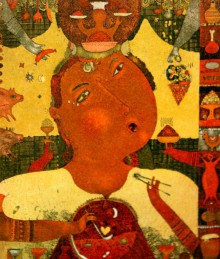Pride, greed, lust, envy, gluttony, wrath, and sloth are the seven deadly sins in the Western tradition. The theme of vices has long been bothering people, particularly artists. “The Seven Deadly Sins,” a new exhibit at the National Bohdan and Varvara Khanenko Museum, focuses on the European artistic tradition, associated with this matter, in contemporary graphics.
The project’s central artwork is Pieter van der Heyden’s authentic engraving Wrath based on a drawing by Pieter Breugel the Elder and printed in 1558. This is the only sheet of Breugel’s famous series “The Seven Deadly Sins” available in the Khanenko Museum’s collection. Next to it are four series by contemporary graphic artists Yurii Borovytsky, Oleh Denysenko, Roman Romanyshyn, and Oleksii Fedorenko – on the same seven sins. These authors’ works are from the collection of Andrii Solomenko who has in fact initiated the project.
BOTH POLITICS AND PHILOSOPHY
It is symbolic that “The Seven Deadly Sins” exhibit was opened at the beginning of Lent, a period of repentance and reflections on what is righteous sinful.
In the engraving based on Pieter Breugel the Elder’s drawing, traditional symbols are intertwined with proverbs and even political satire. It is difficult for a present-day spectator to see through all the author’s messages in the work. For this reason, the Khanenko Museum has drawn up a scheme which generalizes the interpretation of certain images by various researchers.
“There are several methods to depict a sin. The oldest one is allegorical figures. It was often a woman with some attributes. For example, pride is a lady with a mirror,” says Olena Shostak, head of the Khanenko Museum’s European graphics section and an exhibit curator. “Hieronymus Bosch, who had a major impact on Breugel the Elder, began showing a sin by way of everyday life scenes. For example, a fistfight is wrath. Then an idea emerged to resort to complex allegories, as is in the case of Breugel.”
A PALETTE OF TECHNIQUES
What perhaps unifies the works of contemporary artists is the theme, for they are very different in terms of execution. On the etchings of Oleh Denysenko, vices are personified by Gothic knights. Oleksii Fedorenko shows sins as reptiles and poisonous plants that pierce people, while death with a scythe is looking on. Roman Romanyshyn has colorized the vices – his works are done in red, yellow, and green. The author also added, for humor’s sake, the eighth sin – collecting – to the standard list.
On his part, Yurii Borovytsky applied mezzo-tinto, a now rare technique that was widespread in the 17th-18th centuries. On his engravings, the figures of people seem to be coming out of the dark. Human bodies look like fabric rags due to the numerous folds of skin. The impression is that fighting your own vices leads to self-improvement, while pandering to your weaknesses turns you into a weak-willed matter.
You can see these high-quality graphics and perhaps recognize your own self a little at “The Seven Deadly Sins” exhibit that will remain open at the Khanenko Museum until May 15.







